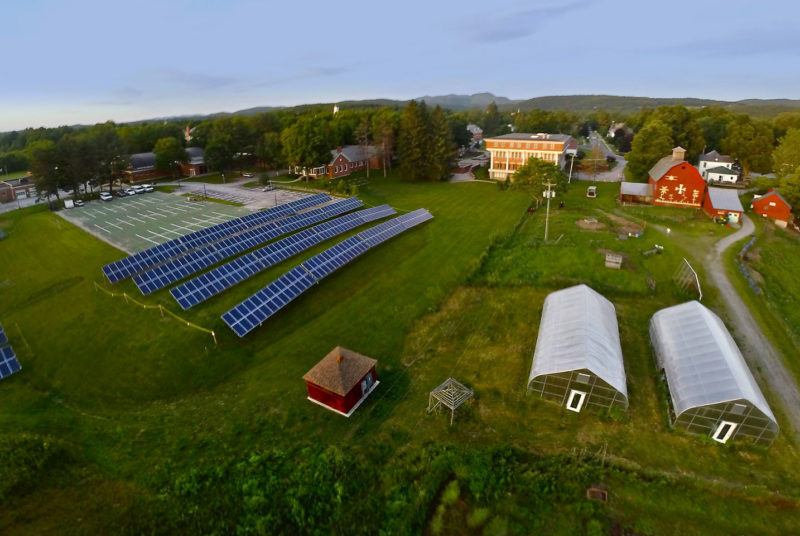5 Schools Moving the Needle on Sustainability

Students install solar panels at College of the Atlantic's Beech Hill Farm. Photo courtesy of College of the Atlantic
These are the colleges and universities making an impact not just on campus, but in the world at large.
As many environmental regulations in the United States are reconsidered and loosened, these colleges and universities are committed to cultivating sustainable campuses and future environmental leaders.

The vegetables harvested by students from University of California, Davis, go to the Yolo County Food Bank. Photo courtesy of Gregory Urquiaga/UC Davis
UNIVERSITY OF CALIFORNIA, DAVIS; DAVIS, CALIF.
U.C. Davis is among the schools leading the way in emissions reduction and waste diversion. The university boasts the largest solar power plant on any campus and diverts 73 percent of its waste from landfills.
“We teach at least 180 courses a year with sustainability content,” says Camille Kirk, the school’s director of sustainability. “Our students are future leaders and active citizens, and they take their U.C. Davis training and go out and do great work in private, public and nonprofit settings.”

College of the Atlantic Ornithology students get a close-up view of some of the bird life in nearby Acadia National Park. Photo courtesy of College of the Atlantic
COLLEGE OF THE ATLANTIC, BAR HARBOR, MAINE
College of the Atlantic is a small school off the coast of Maine that has touted itself as a place “for idealists with elbow grease.”
It was the first school to achieve carbon neutrality, and nearly a decade ago, the school created one of the first sustainable enterprise incubators. Students have developed solar car charging stations, renewable power sources for local businesses and some of the early concepts of urban farms. About three-quarters of students continue to pursue these ventures after graduating, but according to sustainable development professor Jay Friedlander, that’s not the point. “It’s not about cranking out ventures,” he says. “It’s about students experiencing what it’s like to be a sustainable entrepreneur and to do that with a safety net.”

Stanford's bicycle program accommodates an estimated 13,000 bikes on campus daily. Photo courtesy of Office of Sustainability, Stanford University
STANFORD UNIVERSITY, STANFORD, CALIF.Stanford is a leader in two of California’s most critical measures of sustainability: transportation and water usage. In a state where transit is the biggest source of greenhouse gas emissions, 40 percent of campus cars are electric. Meanwhile, the university has reduced potable water use by 49 percent since 2000, helping to offset the effects of a three-year drought.
Stanford is not only building a sustainable community, but providing an open-source model for other institutions as well. “We very meticulously measure our performance,” says Fahmida Ahmed, director of sustainability. “So if there are any questions whenever others are inspired by Stanford and want to replicate that process for themselves, we can actually share that formula with them.”

Graduate students working in Colorado State University's Horticultural Center. Photo courtesy of Colorado State University Photography
COLORADO STATE UNIVERSITY, FORT COLLINS, COLO.
Colorado State University was the world’s first university to achieve a platinum ranking under the Association for the Advancement of Sustainability in Higher Education’s STARS rating system. But the school’s commitment to the environment extends beyond its four walls — research from C.S.U. has been used in massive infrastructure projects and E.P.A. emissions reports, and the university is developing a test site to help companies control their methane emissions. In 2011, the school launched the Center for the New Energy Economy, which works with legislators and regulators to promote clean energy policy.

Green Mountain College has divested from fossil fuels. Photo courtesy of Green Mountain College
GREEN MOUNTAIN COLLEGE, POULTNEY, VT.
This small liberal arts school in the mountains of Vermont was the second institution of higher learning in the country to become carbon neutral. It reportedly generates 85 percent of its heat from a biomass facility on campus that runs on local wood chips. G.M.C. also provides a compelling model in its spending and sourcing. “Where we spend our money matters for the environment and for social justice,” says the school’s sustainability page. The school was among the first American colleges to divest from fossil fuels, and purchases from suppliers that are local, transparent in their supply chain and ecologically responsible.
Syndicated from NationSwell, a new digital media company focused on high-quality stories about American renewal — about the new innovators, pioneers, and builders who are doing the most creative and impactful things to move America forward. Hallie Steiner is a writer and social media manager from Los Angeles. She has written for Buzzworthy and trends consultancy, The Innovation Group.
SHARE YOUR REFLECTION
3 Past Reflections


On Nov 18, 2017 Ed Merrell wrote:
Oberlin College in Ohio has strong sustainability programs as well.

On Nov 18, 2017 Jan Dawson wrote:
Southwestern University in Georgetown, Texas, itself a pioneering green town, is another campus moving toward sustainability with a bike sharing and other green programs.

On Nov 19, 2017 Gahastazu wrote:
Ayni school, Ancora Project, Fazenda da Toca´s project with schools, Schumacher College Brazil. There are others schools that deserve being in that short 5-list.
Post Your Reply